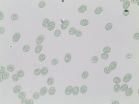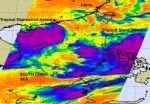(Press-News.org) RICHLAND, Wash. – A new computer model of blue-green algae can predict which of the organism's genes are central to capturing energy from sunlight and other critical processes.
Described in a paper published in the journal Molecular BioSystems, the model could advance efforts to produce biofuel and other energy sources from blue-green algae, known as cyanobacteria. Researchers from the Department of Energy's Pacific Northwest National Laboratory, Washington University in St. Louis and Purdue University developed the model, which was made for the single-celled marine cyanobacterium Cyanothece 51142.
"Our model is the first of its kind for cyanobacteria," said the paper's lead author, PNNL computational biologist Jason McDermott. "Previous models have only zoomed in on specific aspects of cyanobacteria. Ours looks at the entire organism to find out what makes Cyanothece tick."
The research was funded by EMSL, the Department of Energy's Environmental Molecular Sciences Laboratory, a national user facility at PNNL, as part of EMSL's Membrane Biology Grand Challenge. The challenge encouraged scientists to take a systems biology approach to understand the network of genes and proteins that are responsible for photosynthesis and nitrogen fixation in cyanobacteria.
Cyanobacteria are noteworthy because they share qualities with both plants and microbes. They use the sun's energy to make sugar via photosynthesis like plants. And, like microbes, cyanobacteria also convert atmospheric nitrogen – an important nutrient for many organisms – into accessible forms, a process called nitrogen fixation.
Working day and night
Many cyanobacteria physically separate their photosynthetic and nitrogen fixation activities in different cells. But Cyanothece is unusual because the same cell switches between these functions every 12 hours. It makes sugar when there's daylight and then spends the night breaking down that sugar to fix nitrogen and to produce other compounds.
"By understanding which genes trigger Cyanothece to start and stop photosynthesis and other important energy production functions, we may be able to better use cyanobacteria to make renewable energy," McDermott said. Genes serve as the blueprint for the creation of proteins, the cell's workers.
Mapping a gene's purpose
Researchers – many of whom also worked on the model – sequenced Cyanothece's genome in 2008. But knowing how many genes an organism has doesn't necessarily explain what those genes do. So scientists kept studying Cyanothece in the lab. By making a simple linear graph of when different genes were expressed over a 24-hour cycle, McDermott and his co-authors saw that many genes were expressed at similar levels and at similar times. The team hypothesized that such genes were involved in similar processes, such as photosynthesis or nitrogen fixation.
But there isn't always a straight line between one gene being turned on and a cellular process starting. Sometimes a series of genes have to be turned on or off before a process can begin. To better understand these complex relationships, McDermott crafted a circular graph that illustrates how genes are expressed around the clock. Each point on the graph represented a gene being expressed at a particular time. Lines connecting the dots demonstrated how some related genes are expressed one after another in a series.
Points of control
The wreath-like graph revealed a complicated, intertwined network of Cyanothece genes. In some cases, different series of related genes expressed one after another intersected at the same place, at an individual gene or a handful of genes. It appeared that the genes at these intersections serve as bottlenecks, or control points, for the subsequent expression of other genes down the road. The team predicted that if the bottleneck genes were removed, expression of the downstream genes would be affected. Amazingly, 11 of the 25 top bottlenecks identified were genes or proteins whose specific role in Cyanothece weren't previously known.
The next challenge was to figure out how each of these bottlenecks affects Cyanothece's daily life. The team could have done experiments in the lab, removing each of these bottlenecks one at the time from the organism's genome to see what happened. But such experiments can be time-consuming. Seeking a simpler, more methodical solution, the authors built a computer model that would predict the roles of individual genes in Cyanothece.
Central players
They started with a previous whole-organism modeling approach called the Inferelator, which was developed at the Institute for Systems Biology in Seattle for a different microorganism. The team adapted the Inferelator's code to compute the cyclic nature of the connections between Cyanothece's genes. They also added code to improve their ability to test the model's accuracy. When looking at low-oxygen conditions similar to those encountered by Cyanothece at night, the model predicted gene expression levels correctly the equivalent of about 75 percent of the time, in comparison to actual measurements.
The model predicted the roles that a number of bottleneck genes play for Cyanothece. For example, the model predicted that the patB gene is a bottleneck for the production of nitrogenase, the enzyme needed to fix nitrogen. If patB were removed from Cyanothece, the model predicted that nitrogenase production could decrease by as much as 80 percent. The model also identified an unnamed gene, currently labeled as gene cce_0678, as being key to the cyanobacterium's production of RuBisCO, a well-known enzyme that's important in photosynthesis. Without cce_0678, the model predicted RuBisCO production would decrease by about 60 percent.
Next, the research team will seek to further validate the model with lab experiments. They'll remove or increase the expression of specific genes predicted to be bottlenecks to test whether or not they impact Cyanothece's energy production as the model predicted. The researchers will also use the model to examine the complex interactions between important processes in cyanobacteria, such as photosynthesis and nitrogen fixation.
"This model can serve as a first step toward a complete simulation of Cyanothece," McDermott said. "Knowing the detailed inner workings of cyanobacteria could be used to design efficient methods to make bioenergy and manage the carbon cycle, including the greenhouse gas carbon dioxide."
INFORMATION:
REFERENCE: Jason E. McDermott, Christopher S. Oehmen, Lee Ann McCue, Eric Hill, Daniel M. Choi, Jana Stöckel, Michelle Liberton, Himadri B. Pakrasi and Louis A. Sherman, A model of cyclic transcriptomic behavior in the cyanobacterium Cyanothece sp. ATCC 51142, Molecular BioSystems, published online June 23, 2011, DOI: 10.1039/C1MB05006K. http://pubs.rsc.org/en/content/articlelanding/2011/mb/c1mb05006k
Pacific Northwest National Laboratory is a Department of Energy Office of Science national laboratory where interdisciplinary teams advance science and technology and deliver solutions to America's most intractable problems in energy, the environment and national security. PNNL employs 4,900 staff, has an annual budget of nearly $1.1 billion, and has been managed by Ohio-based Battelle since the lab's inception in 1965. Follow PNNL on Facebook, LinkedIn and Twitter.
EMSL, the Environmental Molecular Sciences Laboratory, is a national scientific user facility sponsored by the Department of Energy's Office of Science that is located at Pacific Northwest National Laboratory. EMSL offers an open, collaborative environment for scientific discovery to researchers around the world. EMSL's technical experts and suite of custom and advanced instruments are unmatched. Its integrated computational and experimental capabilities enable researchers to realize fundamental scientific insights and create new technologies. Follow EMSL on Facebook.
Model helps pinpoint cyanobacterial genes that capture the sun's energy
Knowledge could improve microorganism as a renewable energy source
2011-06-24
ELSE PRESS RELEASES FROM THIS DATE:
A Brooklyn Purveyor Cellification.com of Unlocked Cell Phones is Celebrating the Arrival of Summer with the Latest Releases; Cellification.com is Offering Price Breaks of Ten Percent or More
2011-06-24
A Brooklyn purveyor of unlocked cell phones is celebrating the arrival of summer with the latest releases from Nokia, Samsung, HTC, and more. In the spirit of Spring Break, Cellification.com is offering price breaks of ten percent or more on select phones and models on a first-come/first-served basis for a limited time only.
The sale is also being held to honor the upcoming one-year anniversary of an FCC ruling that finds unlocked cell phones to be entirely legal.
It was only last year that the FCC released their revised rules governing a number of intellectual property ...
Contaminated cocaine triggers decaying, dying skin
2011-06-24
If the obvious reasons for avoiding recreational drug use aren't off-putting enough, physicians have yet another detrimental consequence to add to the list – crusty, purplish areas of dead skin that are extremely painful and can open the door to nasty infections.
The condition is called purpura. Typical causes include a range of rare disorders, but it is also associated with the use of cocaine. Not just any cocaine, though: Physicians, researchers and health officials believe cocaine contaminated with a de-worming drug commonly used by veterinarians is the culprit. ...
Compound may provide drug therapy approach for Huntington's disease
2011-06-24
DALLAS – June 23, 2011 – UT Southwestern Medical Center researchers have identified compounds that appear to inhibit a signaling pathway in Huntington's disease, a finding that may eventually lead to a potential drug therapy to help slow the progression of degenerative nerve disorders.
"Our studies have uncovered a new therapeutic target for Huntington's disease treatment and possibly for other neurodegenerative diseases," said Dr. Ilya Bezprozvanny, professor of physiology and senior author of the study, published in today's issue of Chemistry and Biology. "In addition, ...
Young Author Writes Book to Help Peers Succeed in Grade School!
2011-06-24
Children love to succeed and do well in school. Watch a child being praised, and you will see his or her face light up with pride. Have you noticed when children do good and receive positive feedback, they want to continue to do good? Unfortunately the opposite is true as well. If young children are not consistently reminded of their manners, they often tend to get in trouble, which can lead to feelings of embarrassment and sadness. In a recent survey, more than 70 percent of U.S. adults said they thought people are ruder now than they were 20 years ago. Guaranteed Success ...
NASA satellite gets 2 tropical cyclones in 1 shot
2011-06-24
The Northwestern Pacific Ocean is active with two tropical cyclones today, Tropical Storm Meari near the Philippines, and Tropical Depression Haima moving over China and now toward Vietnam. NASA's Aqua satellite passed over the region on June 22 and captured an infrared image of both storms in one image.
One of the instruments onboard NASA's Aqua satellite is the Atmospheric Infrared Sounder (AIRS). AIRS captures cloud top temperatures in tropical cyclones to determine the strength of convection and thunderstorms. The strongest thunderstorms have cloud tops with icy cold ...
Solar wind samples give insight into birth of solar system
2011-06-24
LOS ALAMOS, New Mexico, June 23, 2011—Two papers in this week's issue of Science report the first oxygen and nitrogen isotopic measurements of the Sun, demonstrating that they are verydifferent from the same elements on Earth. These results were the top two priorities of NASA's Genesis mission, which was the first spacecraft to return from beyond the Moon, crashing in the Utah desert in 2004 after its parachute failed to deploy during re-entry.
Most of the Genesis payload consisted of fragile solar-wind collectors, which had been exposed to the solar particles over a ...
New insights into origin of deadly cancer
2011-06-24
Boston, MA—Researchers have discovered a new mechanism for the origin of Barrett's esophagus, an intestine-like growth in the esophagus that is triggered by chronic acid reflux and often progresses to esophageal cancer. Studying mice, the researchers found that Barrett's esophagus arises not from mutant cells in the esophagus but rather a small group of previously overlooked cells present in all adults that can rapidly expand to cancer precursors when the normal esophagus is damaged by acid.
This research will be published online in the June 24th issue of Cell.
Decades ...
Study: Long-term inhaled corticosteroid use increases fracture risk in lung disease patients
2011-06-24
Patients with chronic obstructive pulmonary disease (COPD) who use inhaled corticosteroids to improve breathing for more than six months have a 27 percent increased risk of bone fractures, new Johns Hopkins-led research suggests.
Because the research subjects were mostly men age 60 and older, the findings raise perhaps more troubling questions about the medication's effects on women with COPD, a group already at a significantly higher risk than men for fractures.
"There are millions of COPD patients who use long-term inhaled corticosteroids in the United States and ...
StarChild Science: Planting Daddy's Socks
2011-06-24
Suburban Hobby Farmer asked us what was the most important lesson children have learned in a garden in my classes. My answer comes from our walks through the forest, an empty lot, a patch of earth on a farm, a small tract of woodland while wearing a pair of Daddy's socks. At the end of these walks the children plant the socks into a flat full of potting soil and a magic journey full of promise and faith begins. From here on out every child who plants their daddy's socks after walking through a forest with the socks over their tennis shoes is intimately connected to any ...
Hereditary colon cancer syndrome marked by abnormally dense blood vessel growth in mouth
2011-06-24
A team led by Johns Hopkins researchers has found that a hereditary colon cancer syndrome, familial adenomatous polyposis (FAP), is associated with abnormally dense blood vessel growth in the skin lining the mouth.
The finding, reported in the June issue of Familial Cancer, could lead to a quick screening test for FAP, which is normally diagnosed with expensive DNA tests and colonoscopies, and sometimes goes unnoticed until cancer develops.
"This higher blood vessel density in the mouth may reflect an abnormal state of cells lining the digestive tract – including the ...
LAST 30 PRESS RELEASES:
Tracing the quick synthesis of an industrially important catalyst
New software sheds light on cancer’s hidden genetic networks
UT Health San Antonio awarded $3 million in CPRIT grants to bolster cancer research and prevention efforts in South Texas
Third symposium spotlights global challenge of new contaminants in China’s fight against pollution
From straw to soil harmony: International team reveals how biochar supercharges carbon-smart farming
Myeloma: How AI is redrawing the map of cancer care
Manhattan E. Charurat, Ph.D., MHS invested as the Homer and Martha Gudelsky Distinguished Professor in Medicine at the University of Maryland School of Medicine
Insilico Medicine’s Pharma.AI Q4 Winter Launch Recap: Revolutionizing drug discovery with cutting-edge AI innovations, accelerating the path to pharmaceutical superintelligence
Nanoplastics have diet-dependent impacts on digestive system health
Brain neuron death occurs throughout life and increases with age, a natural human protein drug may halt neuron death in Alzheimer’s disease
SPIE and CLP announce the recipients of the 2025 Advanced Photonics Young Innovator Award
Lessons from the Caldor Fire’s Christmas Valley ‘Miracle’
Ant societies rose by trading individual protection for collective power
Research reveals how ancient viral DNA shapes early embryonic development
A molecular gatekeeper that controls protein synthesis
New ‘cloaking device’ concept to shield sensitive tech from magnetic fields
Researchers show impact of mountain building and climate change on alpine biodiversity
Study models the transition from Neanderthals to modern humans in Europe
University of Phoenix College of Doctoral Studies releases white paper on AI-driven skilling to reduce burnout and restore worker autonomy
AIs fail at the game of visual “telephone”
The levers for a sustainable food system
Potential changes in US homelessness by ending federal support for housing first programs
Vulnerability of large language models to prompt injection when providing medical advice
Researchers develop new system for high-energy-density, long-life, multi-electron transfer bromine-based flow batteries
Ending federal support for housing first programs could increase U.S. homelessness by 5% in one year, new JAMA study finds
New research uncovers molecular ‘safety switch’ shielding cancers from immune attack
Bacteria resisting viral infection can still sink carbon to ocean floor
Younger biological age may increase depression risk in older women during COVID-19
Bharat Innovates 2026 National Basecamp Showcases India’s Most Promising Deep-Tech Ventures
Here’s what determines whether your income level rises or falls
[Press-News.org] Model helps pinpoint cyanobacterial genes that capture the sun's energyKnowledge could improve microorganism as a renewable energy source



